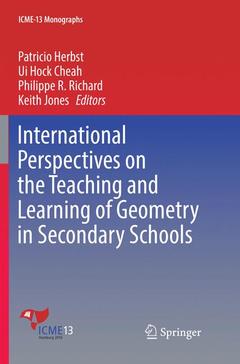Description
International Perspectives on the Teaching and Learning of Geometry in Secondary Schools, 1st ed. 2018
ICME-13 Monographs Series
Coordinators: Herbst Patricio, Cheah Ui Hock, Richard Philippe R., Jones Keith
Language: English
Subjects for International Perspectives on the Teaching and Learning...:
Keywords
geometry learning; geometry instruction; teacher knowledge of geometry; technology use in geometry; geometry curriculum; geometry in secondary schools; teaching and learning geometry; geometrical paradigms; Regular 4-Polytopes; Geometry To Algebra; Geometry teachers; mathematical literacy; pre-service geometry; geometry learning; Geodikon; spatial thinking in problem solving; spatial visualization; non-routine geometry; playing with geometry; dynamic geometry approach
Publication date: 01-2019
Support: Print on demand
Publication date: 05-2018
Support: Print on demand
Description
/li>Contents
/li>Comment
/li>
This book presents current perspectives on theoretical and empirical issues related to the teaching and learning of geometry at secondary schools. It contains chapters contributing to three main areas. A first set of chapters examines mathematical, epistemological, and curricular perspectives. A second set of chapters presents studies on geometry instruction and teacher knowledge, and a third set of chapters offers studies on geometry thinking and learning. Specific research topics addressed also include teaching practice, learning trajectories, learning difficulties, technological resources, instructional design, assessments, textbook analyses, and teacher education in geometry.
Geometry remains an essential and critical topic in school mathematics. As they learn geometry, students develop essential mathematical thinking and visualization skills and learn a language that helps them relate to and interact with the physical world. Geometry has traditionally been included as a subject of study in secondary mathematics curricula, but it has also featured as a resource in out-of-school problem solving, and has been connected to various human activities such as sports, games, and artwork. Furthermore, geometry often plays a role in teacher preparation, undergraduate mathematics, and at the workplace. New technologies, including dynamic geometry software, computer-assisted design software, and geometric positioning systems, have provided more resources for teachers to design environments and tasks in which students can learn and use geometry. In this context, research on the teaching and learning of geometry will continue to be a key element on the research agendas of mathematics educators, as researchers continue to look for ways to enhance student learning and to understand student thinking and teachers? decision making.
Thinking About The Teaching Of Geometry Through The Lens Of Geometrical Work And Geometrical Paradigms
Alain Kuzniak
Epistemological Features Of A Constructional Approach To Regular 4-Polytopes
Stephan Berendonk and Marc Sauerwein
Geometry Opportunites For Reasoning And Proof In Secondary School Textbooks In Trinidad And Tobago
Andrew A. Hunte
Enacting Functions From Geometry To Algebra
Scott Steketee and Daniel Scher
Section 2: Studies of Geometry Instruction and Teacher Knowledge
Examining The Work Of Teaching Geometry As A Subject-Specific Phenomenon
Patricio Herbst, Nicolas Boileau, and Umut Gürsel
Creating Profiles Of Geometry Teachers’ Pedagogical Content Knowledge
Agida G. Manizade and Dragana Martinovic
Symbiosis Between Subject Matter And Pedagogical Knowledge In Geometry
Mohan Chinnappan, Bruce White, and Sven Trenholm
Designing Instruction Towards Mathematical Literacy In Geometry: A Case Study
Ui Hock Cheah
Minding the Gap: A Comparison Between Pre-Service and Practicing High School Geometry Teachers’ Geometry Teaching Knowledge
Shawnda Smith
Some Notes On Teaching Geometry In Secondary School: A Teacher Training Experience
Alejandra Almirón, Susana Ammann, Fernando Bifano, Rosa Ferragina, Gema Fioriti, Leonardo Lupinacci, and José Villella.
Section 3: Studies of Geometry Thinking and Learning
Exploring Models Of Secondary Geometry Achievement
Sharon L. Senk, Denisse R. Thompson, Yi-Hsin Chen, and Kevin J. Voogt
Connectedness Of Problems And Blockage Resolution In The Solving Process: A Major Educational Challenge
Josep Fortuny, Michel Gagnon, and Philippe Richard
The Use Of Writing As A Metacognitive Tool In Geometry Learning
Luz Graciela Orozco Vaca
Development Of Spatial Ability Results From The Research Project Geodikon
Guenter Maresch
Middle School Students' Use Of Property Knowledge And Spatial Visualization In Reasoning About 2D Rotations
Michael T. Battista and Leah M. Frazee
Aspects of Spatial Thinking In Problem Solving: Focusing On Viewpoints In Constructing Internal Representation
Mitsue Arai
Engaging Students with Non-Routine Geometry Proof Tasks
Michelle Cirillo
Playing With Geometry: An Educational Inquiry Game Activity
Yael Luz and Carlotta Soldano
Differences In Self-Reported Instructional Strategies Using A Dynamic Geometry Approach That Impact Students’ Conjecturing
Brittany Webre, Shawnda Smith, and Gilbert Cuevas
Conclusion
The Editors
Presents a wealth of perspectives on how to innovate in teaching geometry
Offers ideas for conceptualizing studies of geometry instruction and analyzing classroom data
Offers information on the current state of geometry instruction around the world




